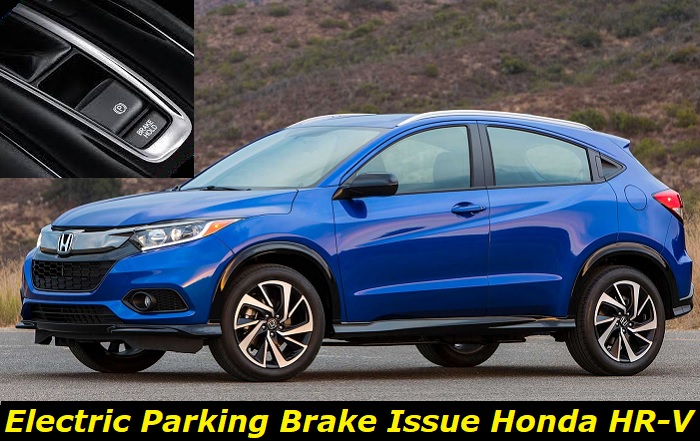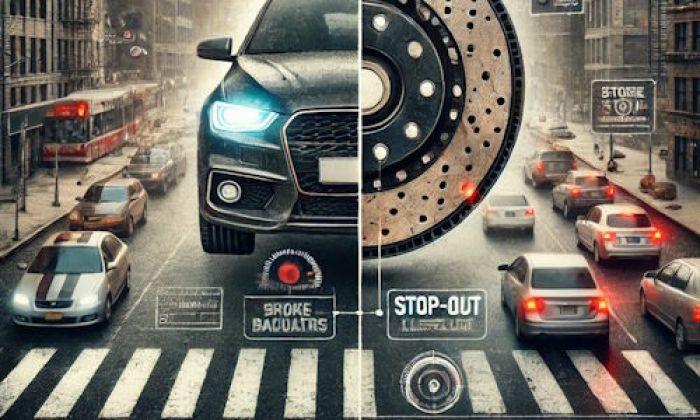You'll never know there are Electronic Parking Brake (EOB) System issues until your Honda HR-V starts flashing parking lights like a Christmas tree on your dashboard. Anyone would start panicking when they find these lights behave like pop-up lights. No one wants to drive in fear of having rear brakes that may not work as they should or suddenly slam out of nowhere without cars or anything nearby.
Electric parking brake problem message highlights
- Common reasons:parking brake motor, EPB control module issue, 12V battery weak
- How to fix:check the battery, read the codes, try disconnecting the battery for some time
- Possible consequences:parking brake may not be engaged
- Priority level:High
- Can you drive?Yes
- DIY repair:Possible but complicated
- Repair price range:$50-$500

How Should HR-V Electric Parking Brake Work?
The HR-V electric parking brake is useful for many situations, such as emergencies. Before, we used a lever to engage and disengage the parking brake. Today, we only have to press the EPB brake button and release the brake pedal to activate the system.
Drivers activate the emergency parking brake to help during emergency cases when the car's front brake system fails. For parked HRVs, the system keeps it in place when parked on steep or inclining surfaces such as hills. When activated, the vehicle will not roll or move on its own.
The system uses a caliper-integrated system to engage with the transmission system and prevent the rear from rotating. This system makes it especially useful for parking and driving on stop-and-go roads.
Should You Take Honda HR-V Electric Parking Brake Problems Seriously?
While most issues are not on the parking brake itself, no driver should ignore signals from your HR-V's EPB.
Your parking lights are the indicator that your emergency brake system has issues. There are many underlying issues in which the dashboard sends signals.
Let's look at the severity of different problems on your EPB.
- If the Parking Brake Button Switch is Dirty
A lot of owners need to replace their switch buttons. Your console usually gets spilled on. And if not used or in contact with liquid frequently, it can build up corrosion. Once the dirt goes into the mechanism of your switch button, it may affect its functionality.
Debris from dirt or corrosion can trigger the button to send wrong signals or not respond at all. If this happens, you are more than close to unsafe driving.
If you have no idea how severe the issue of dirty parking brake buttons is, look at some cases when HR-V suddenly stops or moves slowly without any outside triggers like cars, bumpy roads, or steep inclinations. It may even trigger acceleration even if you haven't touched anything. Even if you didn't have any injury the first time, it decreases your confidence in the car.
You will never know that you need to replace the switch button until you have scanned your EPB for troubleshooting. In most cases where you have to replace the switch button, you can order parts and replace them yourself or have your technician replace them.
- If there are Wiring Problems in Any Part of the EPB System
Wiring problems are the culprit for miscommunications between the console and your EPB module. You will never know the cause of the problem until you bring your HR-V for scanning.
Your EPB dashboard could receive EPB signals or not any triggers at all. At times, it could be unresponsive when it needs to be. It affects how it transmits signals to the system when it has open or broken wires, blown-up fuse, or low voltage.
When this happens, driving with your HR-V is not safe. Check the wires and clips between the actuator or module and the switch if they have secure connections.
Is it serious? Imagine a situation when you thought you engaged the EPB system, only to find it unresponsive. When driving with unresponsive EPB, you can manually release the parking brakes. But if it doesn't, try to switch back using the regular brakes. A lot of owners have no choice but opt for this.
The best way to secure wiring connections is to bring them to your service shop for scanning and troubleshooting. They have scanning tools to see error codes in your EPB and wiring diagrams to locate loose or open wires in the system.
- If your EPB System has a Faulty Servo Motor
Servo motors lock the wheels through the calipers when you activate EPB. But it wears out over time when used unnecessarily. When it keeps trying to stop the tires when not needed, it enforces more tension on the motor, causing it to wear out.
When the EPB's motor is faulty, you may feel the brake pads pressing more softly than they used to. It will not work as a parking or emergency brake. You may skid off steep inclinations or move faster when driving on a stop-and-go road.
- If there are Power Supply Issues with the EPB System
The EPB system will not release or disengage on a dead battery. You would have to jump-start your vehicle's battery to do it.
Moreover, it will not work with a low power supply. You must ensure that the wires connected to your power supply are firm. Also, testing its voltage is a must. The EPB system needs enough power supply to do its job.
What Can You Do if You Notice Your EPB is Failing?
The first thing to do is calm down. If you are driving, try to park it safe if you can. Call your service technician.
If you have a better time, schedule your HR-V for scanning. Most cars today use a computer to engage and disengage their parking brake. And it only needs special equipment, the scanning tool, to troubleshoot your emergency parking brake problem.
Here's the secret to keeping your EPB system working in good condition to avoid any accidents. Make it a habit to ensure the components are clean, especially the switch button. Next, always check its power supply. Invest in a multi-meter for your carry-on toolbox. And lastly, inspect your wirings regularly to ensure they haven't loosened up over time.
And if ever those parking lights showed up once or twice and disappeared, there's a possibility it may reappear. Go to your trusted professional.
So yeah, any HR-V EPB problem is a serious issue. Never put your safety at risk.
About the authors
The CarAraC research team is composed of seasoned auto mechanics and automotive industry professionals, including individuals with advanced degrees and certifications in their field. Our team members boast prestigious credentials, reflecting their extensive knowledge and skills. These qualifications include: IMI: Institute of the Motor Industry, ASE-Certified Master Automobile Technicians; Coventry University, Graduate of MA in Automotive Journalism; Politecnico di Torino, Italy, MS Automotive Engineering; Ss. Cyril and Methodius University in Skopje, Mechanical University in Skopje; TOC Automotive College; DHA Suffa University, Department of Mechanical Engineering






Add comment